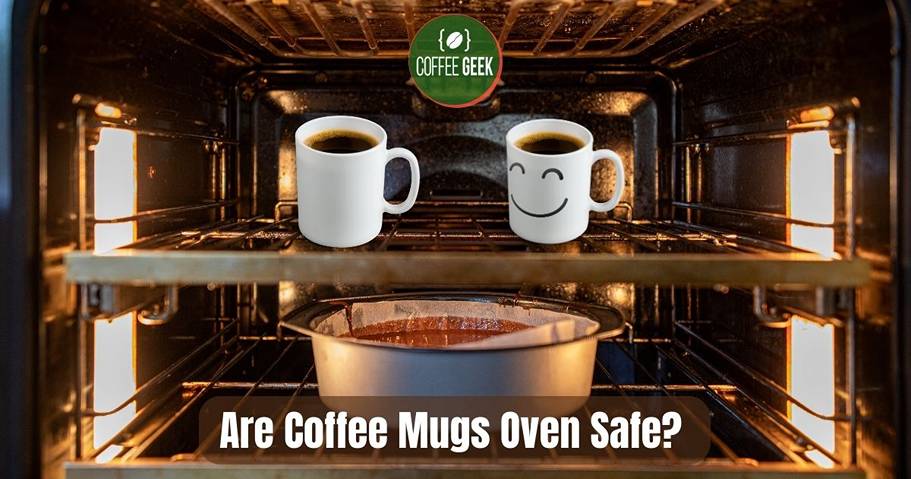When it comes to using mugs in the oven, you might wonder if they are safe to put in the oven.
Mugs are commonly made from materials such as ceramic, porcelain, or stoneware, which have different heat tolerances and characteristics.
Therefore, it’s essential to know whether the material your mug is made from can safely withstand oven temperatures.
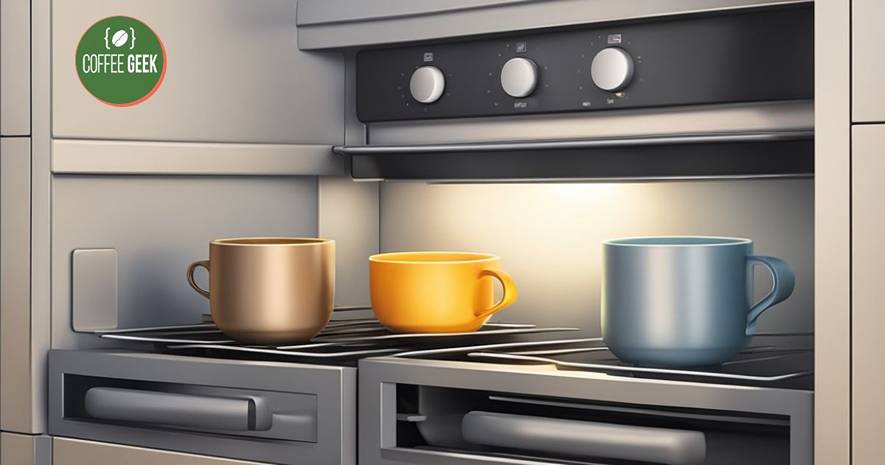
Are mugs oven safe? Not all mugs are oven-safe, and putting the wrong type of mug in the oven can lead to damage or even injury.
It is important to consider factors such as material and manufacturer guidelines when determining whether a mug is oven-safe.
Understanding these factors and following usage tips can help ensure the safety and longevity of your mugs, and prevent accidents in the kitchen.
Key Takeaways
- Oven-safe mugs depend on the material and manufacturer recommendations.
- Always consider material and manufacturer guidelines before placing a mug in the oven.
- Proper usage tips can help ensure safety while using oven-safe mugs.
Are Mugs Oven Safe?

Ceramic and Porcelain
Ceramic and porcelain mugs are generally considered oven-safe if they have no metallic decorations or components.
However, you should always check the specific item for an “oven-safe” designation.
While ceramic and porcelain mugs can usually withstand high temperatures, some glazes or decorations may contain compounds that are unsafe when heated.
Glass and Borosilicate Glass
Glass mugs made from regular glass should not be used in the oven, as they may break due to sudden temperature changes.
On the other hand, borosilicate glass mugs are designed to handle extreme temperatures, making them oven-safe.
Borosilicate glass mugs are often labeled as microwave and oven-safe, making it easier for you to determine their suitability for oven use.
Metal and Steel Mugs
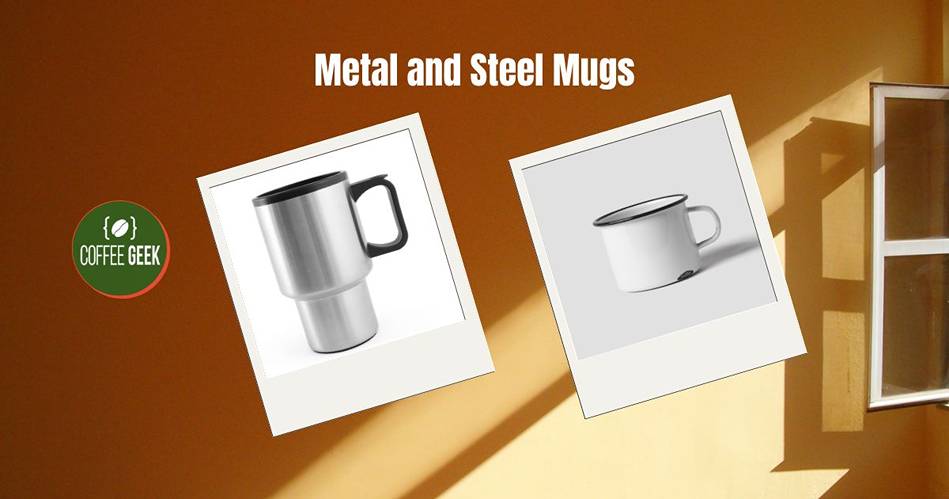
Metal and steel mugs may be oven-safe, but not all types are suitable for oven use.
Depending on the thickness and specific metal composition, a metal or steel mug may not handle high oven temperatures well.
Always verify whether a specific metal mug has been labeled as oven-safe before use.
Additionally, remember that metal mugs should never be placed in the microwave, as this can lead to sparks and fires.
Stoneware
Mugs made of stoneware are usually oven-safe, thanks to their dense and durable composition.
These mugs can handle high temperatures without cracking or breaking.
However, always check for the “oven-safe” labeling before placing a stoneware mug in the oven to avoid any potential issues.
Other Materials
Some other materials, such as silicone, wood, and plastic, should not be used in the oven. Silicone mugs may be able to handle heat, but it’s essential to verify their temperature limit first.
Wood and plastic mugs should never be placed in the oven, as they could emit harmful chemicals or even catch fire.
When choosing a mug for oven use, always prioritize oven-safe materials and check for proper labeling.
As a general rule, it’s better to be safe than sorry.
Avoid using mugs with decorative elements or unknown materials in the oven to reduce the risk of accidents and damage.
Factors Determining Oven-Safety

Material Composition
The primary factor that determines whether a mug is oven-safe is its material composition. Different materials can withstand various temperature levels.
For instance, stoneware and porcelain are generally considered oven-safe materials, as they can tolerate high temperatures without breaking or degrading.
However, some materials might not be suitable for oven use, such as plastic or those with a non-stick coating.
Temperature Thresholds
The maximum temperature that a mug can tolerate is crucial when determining its oven-safety. While some mugs are labeled as oven-safe, they might only withstand temperatures up to a specific level.
For example, your mug may be:
- Safe up to 200°F (93°C): Suitable for warming, but not for baking
- Safe up to 350°F (177°C): Ideal for most baking recipes
- Safe up to 450°F (232°C): Can handle high-temperature cooking
It’s essential to know your mug’s maximum temperature to prevent damage or accidents in your kitchen.
Thermal Shock Resistance
Another aspect to consider is the mug’s thermal shock resistance, which indicates its ability to handle sudden temperature changes without cracking.
A high-quality stoneware or porcelain mug usually has good thermal shock resistance, allowing it to safely move from the refrigerator to the oven.
However, inexpensive or thin porcelain mugs may not have a high resistance to thermal shock and could break if exposed to abrupt temperature fluctuations.
Product Design and Structure
The design and structure of your mug play a significant role in determining its oven-safety.
Features such as insulation or thermal protection allow the mug to withstand higher temperatures.
However, certain decorative elements, like painted designs or metallic gold trim, might not be suitable for oven use and could cause damage to the mug or your oven.
To identify oven-safe mugs, always look for the oven-safe symbol or check the manufacturer’s guidelines before using any mug in your cooking endeavors.
By understanding these factors, you can safely determine whether your mug is suitable for oven use and enjoy your meals without worrying about potential accidents or damages.
Manufacturer Guidelines and Standards

Safety Symbols and Markings
When determining if a mug is oven-safe, it is crucial to check the manufacturer’s safety symbols and markings of mug that is oven safe.
They are typically found on the bottom of the mug or on the packaging.
Common symbols include “oven-proof” or “microwave-safe” to indicate that it is safe to use in the oven or microwave, respectively.
In some cases, manufacturers will also provide the maximum temperature the mug can withstand.
Make sure to adhere to these guidelines to ensure safety while using the mug in the oven.
Care Instructions
Manufacturers may also supply specific care instructions, such as whether the mug is dishwasher safe or requires hand-washing.
Follow these guidelines to maintain the mug’s condition and prolong its life.

However, plastic and glass mugs may not be oven-safe and the manufacturer may advise against oven-use.
Please, respect the manufacturer’s instructions to avoid any damage to your mugs or potential safety hazards.
Packaging Notations
It’s essential to examine the mug’s packaging for additional notations regarding its oven safety.
Some manufacturers will include warnings about potential hazards, such as cracking or melting if the mug is exposed to high temperatures.
By considering specific materials, like stoneware, borosilicate glass, metal, enamel, or silicone, you can identify if they are oven-safe.
Conversely, other materials may not withstand high temperatures, and therefore, using them in the oven can be unsafe.
Remember always to consult the manufacturer’s guidelines for oven safety and care instructions before using a mug in the oven.
This way, you can enjoy your culinary creations while ensuring the safety and longevity of your kitchenware.
Identifying Oven-Safe Mugs
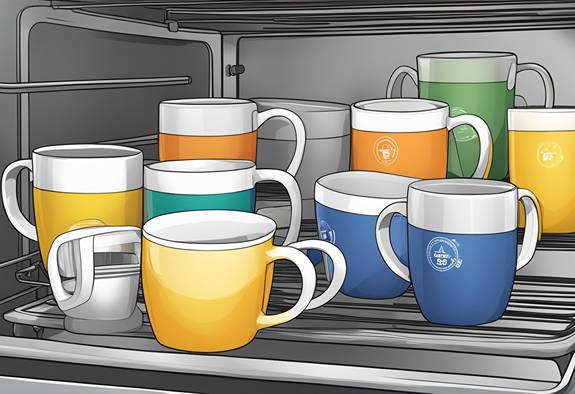
Visual Inspection
To determine if a mug is oven-safe, start by examining the material. Ceramic and stoneware mugs are usually safe for oven use, as they can withstand high temperatures.
On the other hand, plastic and glass mugs may not be suitable for oven use, as they can crack or melt under intense heat.
It’s also crucial to examine the mug’s handle, as it may be made of a different material that can become damaged in the oven.
Checking for Labels
Another important step in identifying oven-safe mugs is to check for labels. Look for marks such as “oven-proof” or “microwave-safe” on the bottom of the mug or the packaging.
While a microwave-safe mug can handle microwave energy, it doesn’t necessarily mean it’s safe for oven use, as microwaves and ovens use different heating methods.
Always check the manufacturer’s instructions to be certain.
When searching for oven-safe mugs, consider those with a nonstick surface.
These mugs will not only be easier to clean, but they also ensure convenient baking and effortless food release.
Here is a summary of the key points to remember when identifying oven-safe mugs:
- Safe materials: Ceramic, stoneware
- Unsafe materials: Plastic, glass
- Labels: Oven-proof, microwave-safe
- Nonstick surface: Easier to clean and food release
By following these tips, you can ensure that you’re using an appropriate mug for your oven-based recipes, keeping your kitchen safe and your food delicious.
Usage Tips for Oven-Safe Mugs
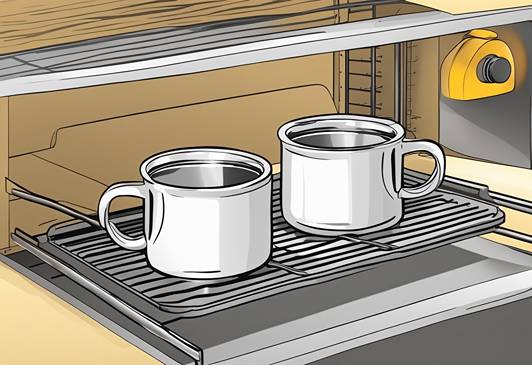
Baking with Mugs
When using your oven-safe mugs, it’s essential to choose the right material.
Select sturdy materials like stoneware, borosilicate glass, metal, enamel, and silicone which are all oven-safe.
Avoid using plastic or regular glass coffee mugs, as they may crack or melt under high temperatures.
To make delicious baked treats, follow these simple steps:
- Preheat your oven to the temperature specified in the recipe.
- Grease your oven-safe mug to prevent the baked goods from sticking.
- Prepare the batter according to the recipe’s instructions.
- Fill the mug halfway to allow room for expansion during baking.
- Place the mug in the preheated oven and bake for the required time.
Preparing Mug Cakes
Mug cakes are a quick and convenient treat to prepare in your microwave-safe mug.
Follow these steps to create a delicious mug cake:
- Choose a microwave-safe mug made of ceramic or oven-safe glass.
- Combine all ingredients in the mug, making sure to mix thoroughly.
- Microwave on high for the time specified in the recipe (usually around 1-2 minutes).
- Allow the mug cake to cool for a minute before enjoying your treat.
Note: Remember to check the wattage of your microwave before preparing your mug cake to ensure proper cooking times.
General Handling and Precautions
When using oven-safe mugs, always practice caution and follow these general handling tips:
- Check the manufacturer’s instructions to ensure your specific mug is oven-safe.
- Use oven mitts or a towel to handle hot mugs to prevent burns.
- Avoid using mugs with metallic parts like gold or silver rims, as they can cause sparks or damage in the microwave.
- Allow the mug to cool before washing or transferring it to a different temperature environment (e.g., from the oven to the fridge) to prevent thermal shock and cracking.
By following these tips, you can safely use your oven-safe mugs for various baking and cooking tasks while maintaining their durability and functionality.
| Mug Material | Oven Safe? | Notes |
|---|---|---|
| Ceramic | Yes, if labeled as such | Many ceramic mugs are oven safe, but it’s important to check for specific labeling or manufacturer instructions. Always avoid rapid temperature changes to prevent cracking. |
| Stoneware | Yes | Stoneware mugs are typically oven safe, but it’s essential to check individual product information for specific temperature limits and care instructions. |
| Porcelain | Yes | Oven safety may vary, so it’s crucial to check the manufacturer’s guidelines. High-quality porcelain mugs are often oven safe within certain temperature ranges. |
| Glass | Generally, no | Most glass mugs are not oven safe due to the risk of thermal shock. Check the manufacturer’s recommendations for specific products. |
| Stainless Steel | Generally, no | While stainless steel is oven-safe, many mugs have non-metal parts like handles or coatings that may not be suitable for the oven. Refer to the product’s instructions. |
| Plastic | No | Most plastic mugs are not oven safe, as they can melt or release harmful chemicals at high temperatures. Always follow the manufacturer’s guidelines. |
| Enamel-Coated | Yes, with limitations | Enamel-coated mugs are generally oven safe, but temperature limitations may apply. Excessive heat can damage the enamel. Follow the manufacturer’s recommendations. |
Final Words
Determining whether a mug is oven safe is crucial for coffee enthusiasts who want to use their favorite coffee mug in various cooking applications, like heating soup or baking desserts.
While many coffee mugs are marked oven safe, it’s important to understand the different materials and their capabilities to ensure safety and avoid damage.
Stoneware mugs are generally oven safe mugs, making them a versatile choice for both coffee or tea and for heating food in the oven.
Similarly, porcelain coffee mugs can usually withstand oven temperatures, provided they are glazed and marked as oven safe. Ceramic coffee mugs, including those in a coffee mug set of 4 or 6, are also commonly oven safe.
However, not all ceramic cups are created equal, and their resistance to high temperatures can vary.
The Dowan Coffee Mug, for example, is a popular choice available on Amazon, often appreciated for its oven-safe properties.
This particular mug set, which might come in a set of 4 or 6, is often unique glazed microwave safe, and oven safe, making it suitable for a range of uses.
When it comes to oversized mugs or soup bowls with handles, like the meal mug with vented lid, the capacity to go from freezer to the oven is a valued feature.
However, it’s crucial to avoid sudden temperature changes, known as thermal shock, as this can cause materials like bone china mugs to crack in the oven.
Glazed ceramic, such as in the Sweese Porcelain Coffee Mugs or 17 oz mugs ceramic, can typically withstand these changes better.
For those who own a microwave oven safe or conventional oven safe coffee mug, such as a 16 oz ceramic or white mug, using it in the oven is usually fine.
Nonetheless, always check if your mug is marked oven safe before putting it in the oven. Remember, microwave safe does not always mean oven safe.
In summary, while many coffee mugs, like the black coffee mugs or the camping mug, can be safely used in the oven, it’s essential to verify their oven-safe status and material composition.
Always read the manufacturer’s instructions and avoid sudden temperature changes to prevent damage to your mug and ensure safe usage.
Frequently Asked Questions
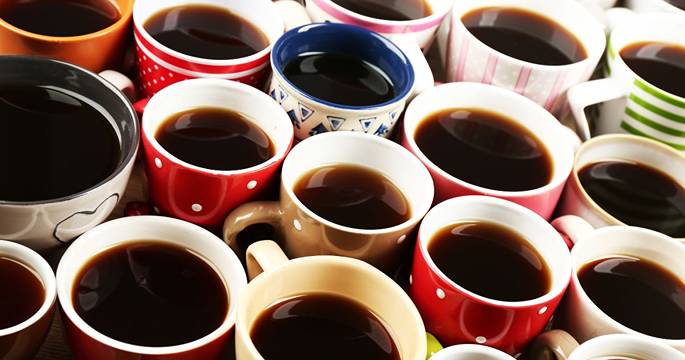
Can I put a coffee mug in the oven?
Whether you can put a mug in the oven all depends on the material it is made from. For example, stoneware mugs are oven safe and can indeed go in the oven. However, some materials may be susceptible to thermal shock and could crack if exposed to extreme temperature changes. Make sure your mug is labeled as oven-safe before placing it in the oven.
Are all mugs oven safe?
Not all mugs are oven safe. While some mugs, such as those made from certain types of stoneware or porcelain, are designed to withstand high temperatures safely, others, like plastic or metal coffee mugs, can’t go in the oven. Always check the manufacturer’s labels or product descriptions to know if a mug is oven safe.
How can I determine if my coffee mug is oven safe?
You can often tell if a coffee mug is oven safe by checking for a label or stamp on the bottom of the mug that indicates it is “Oven Safe.” Additionally, product descriptions and the packaging often state if the mugs are oven safe. If it’s not indicated, you can assume that the mug should not go in the oven unless specific instructions state otherwise.
Can coffee cups handle hot and cold temperatures?
Most coffee cups can handle both hot and cold temperatures. However, not all mugs can go from hot to cold (or vice versa) without a risk of cracking due to thermal shock. This is particularly true if you’re planning to put a coffee mug in the oven. Mugs that are stoneware are oven safe and are designed to handle such temperature fluctuations.
Are coffee mugs set of 6 always oven safe?
Whether a coffee mugs set of 6 is oven safe depends on the type of material each mug is made from. Remember, some materials, including certain types of stoneware or porcelain, are oven safe. If the product’s package or description doesn’t mention anything about being oven safe, it’s best not to risk it unless you’ve verified it with the manufacturer.
Can soup mugs go in the oven?
Yes, many soup mugs can go in the oven, especially if they are made of oven safe materials like stoneware. These mugs are designed to withstand the heat of the oven, so you can cook or keep your soup warm directly in the bowl. Always double-check that the soup mug is oven safe before you use it in this way.
Is a glazed microwave safe and oven safe coffee mug automatically dishwasher safe as well?
Not necessarily. While many mugs that are safe for use in the oven and microwave are also dishwasher safe, this is not always the case. Always check the manufacturer’s instructions to make sure. If a mug is dishwasher safe, it should be labeled accordingly.
Can a coffee mug set of four feature different oven safe variants?
Yes, a coffee mug set of 4 can certainly feature mugs made of different materials that are all oven safe. For example, the set could include porcelain coffee mugs, stoneware mugs, and other oven-safe materials. When purchasing a set, ensure to read the products descriptions, so you know what each mug is made of and if it is indeed oven safe.
Can glass mugs go in the oven?
Glass mugs can only go in the oven if they are made from a specific type of oven-safe glass. Regular glass mugs can easily crack or shatter when exposed to high oven temperatures. Always check the manufacturer’s instructions to determine whether a glass mug is oven safe.
Is it safe to use an oven safe coffee mug that has been removed from the oven?
Yes, once an oven safe coffee mug options has been removed from the oven and allowed to cool reasonably, it is safe to use. However, taking a mug directly from the oven, while it’s still hot, can lead to burns, so handle with care using oven mitts and let it cool first before touching.

